Reports
Updated Highlights of Comprehensive Survey of Iran’s Advanced Centrifuges - September 2022[1]
by David Albright, Sarah Burkhard, and Spencer Faragasso
September 22, 2022
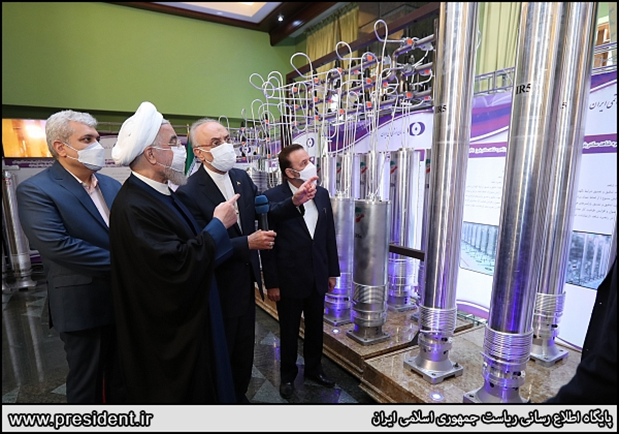
Background and Context
- This report is a quarterly update to our comprehensive overview of the enrichment capacity and deployment of Iran’s advanced gas centrifuges, as well as projections of future advanced centrifuge deployments. It contains new information from the International Atomic Energy Agency’s (IAEA) quarterly report on the verification and monitoring of Iran under the Joint Comprehensive Plan of Action (JCPOA).
- This series of Institute reports aims to provide the public the most recent and comprehensive information on Iran’s advanced centrifuges.
- The advanced centrifuges pose a grave risk to international security, allowing Iran to produce highly enriched uranium for a nuclear weapon more quickly either at declared nuclear sites or at clandestine ones.
Findings
- As of the September 2022 IAEA quarterly report, Iran has 2782 advanced centrifuges of various types installed at its three enrichment facilities at Natanz and Fordow, as well as 7110 installed IR-1 centrifuges. Most of these advanced centrifuges are IR-2m, IR-4, and IR-6 centrifuges.
- Iran has demonstrated its ability to build up its advanced centrifuge numbers rapidly: Over half of the newly installed advanced centrifuges are assumed to have been newly built since 2018; the rest are assumed redeployments of advanced centrifuges Iran was allowed to dismantle and store under the JCPOA in 2015.
- Iran currently has a total installed nominal enrichment capacity of about 18300 separative work units (SWU) per year, where advanced centrifuges account for about 11900 SWU per year and IR-1 centrifuges account for 6400 SWU per year. 2 Since February 2021, Iran’s installed advanced centrifuge nominal enrichment capacity has exceeded its installed capacity of its IR-1 centrifuges, and today accounts for approximately two-thirds of Iran’s total installed enrichment capacity.
- Iran’s latest deployment plans signal that it is shifting its focus from deploying IR-6 and IR-4 centrifuges to deploying IR-2m centrifuges.
- The IAEA stated that due to gaps in relevant monitoring, it has concerns about its ability to verify Iran’s declared centrifuge numbers even if Iran fully cooperated. This adds to the concern about Iran’s ability to sneak-out to a nuclear weapon, using only a small number of secretly-produced advanced centrifuges.
- Iran has gained valuable technical knowhow, experience, and advancements in the designing and building of its advanced centrifuges. Those gains cannot be reversed or erased, presenting further challenges to the value of seeking to reestablish JCPOA limits.
Advanced Centrifuge Deployments
In the last three years, Iran has been deploying advanced centrifuges in violation of the limits in the Joint Comprehensive Plan of Action (JCPOA), following a lull of three years created by those limits. Starting in late 2020 or early 2021, it dramatically increased the number of deployed advanced centrifuges. Iran has demonstrated its commitment to replace the IR-1 centrifuge with advanced centrifuges, which can produce considerably more enriched uranium.
Iran has been deploying advanced centrifuges at three enrichment plants: the above-ground Pilot Fuel Enrichment Plant (PFEP) and the much bigger, below-ground Fuel Enrichment Plant (FEP) at Natanz, and the deeply buried Fordow Fuel Enrichment Plant (FFEP). Iran’s deployments have been slower than expected based on Iran’s official plans, but Iran has made steady progress in deploying IR-2m, IR-4, and IR-6 centrifuges.
Figure H.1 shows the number of advanced centrifuges deployed from 2011 onwards through September 2022, with a projection for the end of 2022 based on Iran’s announced plans. 3 Despite the increases in 2021 and 2022, Iran’s deployments of advanced centrifuges occurred slower than planned, although it has accelerated in recent months. In the last three months, the number of deployed advanced centrifuges increased by 554. Those deployed are primarily IR-6 centrifuges, meaning that Iran now has over 1000 IR-6 centrifuges installed and has met its goal outlined in its December 2020 law. In early August 2022, Iran proclaimed its intention to install an additional six cascades of IR-2m centrifuges at the Natanz FEP. 4 Currently, four of those six new IR-2m cascades are being installed.
One likely cause for Iran’s slower than expected progress is the destruction of the Natanz Iran Centrifuge Assembly Center (ICAC) and a centrifuge manufacturing plant at a site called TABA Karaj (also known as TESA), situated near Karaj. The ICAC was built to have a capacity to make a few to several thousand advanced centrifuges per year. Iran’s subsequent manufacturing and assembly capacity appears to have been substantially reduced, down to a level of several hundred advanced centrifuges per year. Its temporary assembly facility, inaugurated at Natanz in April 2021, about nine months after the attack on the ICAC, has failed to compensate for the destruction. Shortly after, an attack on Iran’s centrifuge manufacturing capabilities at Karaj, and the subsequent, recent transfer of manufacturing capabilities to Natanz, likely delayed production of centrifuges further.
Despite these delays, and taking into account Iran’s ongoing commitment to its earlier announced plans and Iran’s recent announcements of its determination to increase the number of installed advanced centrifuges, Iran accelerated its installation of advanced centrifuges, albeit at a slower rate than it could have without the destruction of these two facilities. Uncertainties have grown in the estimated number of advanced centrifuges produced in excess of those deployed, adding concern to the possibility that Iran will again seek to build a clandestine enrichment plant, using advanced centrifuges manufactured in secret.
Closer Look at the Numbers
Figure H.1 shows a steady increase in the number of advanced centrifuges until 2013, followed by a steady level, and then a sharp drop in 2016, when the JCPOA was implemented with a focus on limiting advanced centrifuge research and development, at least temporarily. That number started to increase again in the fall of 2019, after Iran began to violate the JCPOA, but at a faster rate than prior to the JCPOA, reaching unprecedented deployment levels in May 2021 after a sharp increase after late 2020. For over a year now, the number of deployed advanced centrifuges has exceeded the number deployed prior to the JCPOA. As of September 2021, Iran had approximately 1889 advanced centrifuges installed at its three enrichment plants. By the end of August 2022, the number increased significantly to 2782.
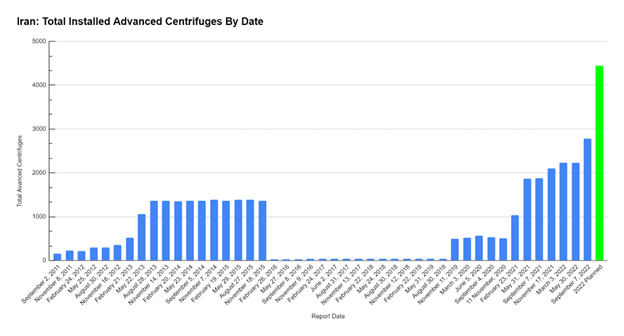
Figure H.1. Iran’s quarterly number of installed advanced centrifuges at its three enrichment plants, with a multi-quarter projection for late-2022 (last vertical bar). (The number of IR-1 centrifuges are ignored in this graph but see Figure H.3 for a complete breakdown of the situation today.) In April 2021, the Natanz FEP was attacked, affecting half of the IR-2m and IR-1 cascades. The total number of installed cascades remained the same but many of the centrifuges could have been destroyed. Since the attack, Iran likely replaced the broken centrifuges in those cascades, although the IAEA does not report how many centrifuges were replaced.
Since August 2019, Iran has installed 2737 advanced centrifuges, including redeploying multiple additional cascades of IR-2m, IR-4, and a variety of other advanced centrifuges. In order to estimate a rate of manufacturing and assembly, the centrifuges installed prior to the JCPOA need to be subtracted from the current total of 2782. Subtracting that number results in 1418 new advanced centrifuges installed since August 2019 and likely manufactured after 2018. On average, Iran has installed 38.3 new advanced centrifuges per month, or 473 per year.
This deployment average is likely a minimal estimate of the manufacturing rate of new centrifuges, since Iran also has to make new advanced centrifuges to replace already installed ones that break, and may have been accumulating a reserve of advanced centrifuges. The latter concern about a reserve, including a possible secret one, is highlighted by the IAEA recent finding that “Even if all records were provided by Iran, additional safeguards measures were applied by the Agency, and the recovered data proved to be comprehensive and accurate, considerable challenges would remain to confirm the consistency of Iran’s declared inventory of centrifuges […].”5
Between May 2022 and September 6, 2022, Iran installed and started to enrich uranium in three production-scale IR-6 cascades at the FEP. Iran now has a total of six production-scale IR-6 cascades installed at the three enrichment plants at Natanz and Fordow for a total of 1056 IR-6 centrifuges, a number in line with the December 2020 legislation mandating that Iran install 1000 IR-6 centrifuges.
Meanwhile, since May 2022, Iran has made little progress installing its third out of six announced IR-4 centrifuge cascades at the FEP. Nonetheless, Iran has continued to reiterate its determination to increase the number of deployed advanced centrifuges over the next several months. In August 2022, Iran announced that it intends to deploy six additional cascades of IR-2m centrifuges at Natanz FEP. The IAEA confirmed in its September 2022 quarterly report that at the Natanz FEP, Iran is currently in the process of installing four of the six additional cascades of IR-2m centrifuges.
In total, based on Iran’s declarations to the IAEA, the Atomic Energy Organization of Iran (AEOI) plans to install up to another 1600 advanced centrifuges, bringing the projected total to about 4440 installed advanced centrifuges.
Iran is still recovering from the attacks on its centrifuge manufacturing and assembly capabilities at Natanz and Karaj. It has successfully established small scale centrifuge manufacturing and assembly facilities at Natanz. In parallel, it continues building a large, replacement centrifuge assembly facility under a mountain south of the FEP, although this facility is not expected to start soon. U.S. officials believe operation will not start in 2022 or 2023. Other officials agree, citing unexpected excavation problems. 6 As a result, over a longer period of time, Iran appears able to deploy the projected additional cascades of advanced centrifuges using existing capabilities, and further increase centrifuge installation as the facility under the mountain comes into full operation, likely with a capacity to assemble thousands of advanced centrifuges per year.
Key Production-Scale Advanced Centrifuges: IR-2m, IR-4, and IR-6 Centrifuges
The most important advanced centrifuges today are the IR-2m, IR-4, and IR-6 centrifuges. The deployments to date largely represent a build-back of stored IR-2m centrifuges and a buildup for the IR-6 centrifuge. It is not clear why the IR-4 centrifuge deployments are not progressing in parallel. It is also not clear whether the additional six cascades of IR-2m centrifuges are newly built centrifuges or were stored in secret prior to the JCPOA and not declared to the IAEA.
One way to see the importance of these three centrifuges is to consider that they can replace the IR-1 centrifuges while utilizing the same existing cascade piping and feed and withdrawal systems at the Natanz and Fordow sites. One notable recent development is that Iran has managed to deploy more IR-2m centrifuges, despite material supply challenges. In addition, Iran continues to be successful in evading national and international controls and sanctions with regards to materials needed for the IR-4 and IR-6 centrifuges.
When Iran started production of 60 percent highly enriched uranium in April 2021, the IR-4 and IR-6 centrifuges were chosen for this task, rather than the ones with which Iran had more operational experience, such as the IR-1 or IR-2m centrifuge. The IR-1 centrifuge has already been used for the production of 20 percent enriched uranium, and the IR-2m centrifuge has been operated in cascades for several years. Further, when choosing to install a cascade at Fordow with sub-headers easily modifiable for producing different levels of enrichment, Iran chose the IR-6 centrifuge.
However, based on the operational experience of the IR-6, as reported by the IAEA, the IR-6 centrifuge does not work as well as expected, despite some design changes. 7 It appears the IR-6 needs more development to reach its nominal enrichment output. This is further supported in the latest quarterly report which indicates that Iran appears to be shifting its focus from deploying the IR-6 and IR-4 centrifuges to deploying additional cascades of IR-2m centrifuges at the Natanz FEP.
In terms of understanding the impact of these three centrifuges, a key value is their estimated average enrichment output when arranged into cascades of about 160-170 centrifuges, called production-scale cascades, the workhorse for enrichment in Iran. These estimated average outputs are less than theoretical values or single centrifuge measured values because of inefficiencies experienced during larger-scale cascade operation. The enrichment output of the IR-2m centrifuge when operating in a production-scale cascade is estimated in the main report (A Comprehensive Survey of Iran’s Advanced Centrifuges, December 2021 available here) at 3.67 SWU per year; the estimated value for the IR-4 centrifuge in a production-scale cascade is 3.3 SWU per year. The equivalent value for the IR-6 centrifuge is harder to discern from the available information, but an estimated value of approximately 5.25 SWU per year appears justified and reasonable for its average output in a production-scale cascade. In general, these more practical outputs are about 75 percent of their single machine theoretical values given in the main report. 8 In practice, lower average values result, due to centrifuge breakage, inefficient operation, or during the production of highly enriched uranium, such as production of 60 percent enriched uranium or weapon-grade uranium. The IR-6 centrifuge, as mentioned above, seems to be underperforming significantly today, but its performance may improve in the future. Nonetheless, the practical enrichment output of these three centrifuges is far higher than that of the IR-1 centrifuge, which has achieved average production-scale cascade values of 0.6-1.0 SWU per year per centrifuge.
Note: The enrichment output unit in this table should not be confused with Iran’s non-standard enrichment output unit (called in the main report the uranium hexafluoride unit). Iran’s unit is significantly larger than the more conventional unit. An analogy would be using liters instead of gallons in front of a U.S. audience, perhaps with the intention to make a value appear larger than it is.
Advanced Centrifuge Development and Status
Figure H.2 is a timeline of the deployment of major advanced centrifuge types; the horizontal axis gives the year in which each type was deployed for the first time at the pilot plant at Natanz, starting with the IR-2 and IR-3 centrifuges in 2008. For comparison purposes, the vertical axis lists each centrifuge’s theoretical enrichment output. It should be noted that, when data exist, the output in practice has proven to be significantly less than predicted by these theoretical values. Some centrifuge types are not included in Figure H.2; these centrifuges are included in Chapter 1 of the main report, along with a more detailed discussion about the theoretical and achieved enrichment outputs of each centrifuge type.
Starting in November 2019, Iran demonstrated that it had accelerated its centrifuge research and development by installing seven types of advanced centrifuges in addition to the existing seven types allowed to be deployed under the JCPOA. These seven additional types were not included in Iran’s confidential JCPOA enrichment plan, which projected the deployment of centrifuges up to about 2030. 9 The seven allowed ones are the IR-2m, IR-4, IR-5, IR-6, IR-6s, IR-7, and IR-8 centrifuges. The seven not allowed to be deployed under the JCPOA are the IR-3, IR-s, IR-6M, IR-6sm, IR-8B, IR-8s, and IR-9 centrifuges. Of these, all but the IR-3 centrifuge are new models.
Iran’s rapid deployment of many advanced centrifuges in 2019, including many new models, suggests that centrifuge development work continued during the period when the JCPOA was in force and accelerated secretly at least as soon as the United States ended its participation in the JCPOA in May 2018. For example, Iran changed the endcap design on some of the IR-6 centrifuge rotors from flat to domed. By early 2021, for testing purposes, Iran started to make maraging steel bellows for the IR-6 instead of carbon fiber, perhaps indicating ongoing problems in those bellows. 10
Of the fifteen advanced centrifuge types in Figure H.2, based on the September 2022 quarterly IAEA report, the IR-2m, IR-4, IR-5, IR-6, IR-6s, and IR-s centrifuges were accumulating enriched uranium. The IR-7, IR-8, IR-8B, and IR-9 centrifuges were being tested with natural uranium feed but not accumulating enriched uranium. As of September 2022, not a single IR-2, IR-3, IR-6M, IR-6sm, or IR-8s centrifuge was listed as present in any of the three enrichment plants. The IR-2 and IR-3 centrifuges may have been retired. An additional new centrifuge type, the IR9-1B, is discussed in Chapter 1 in the main report, but it has not been deployed at the PFEP to this date and is not included in Figure H.2. Figure H.3 shows the fraction of each type in a pie chart.
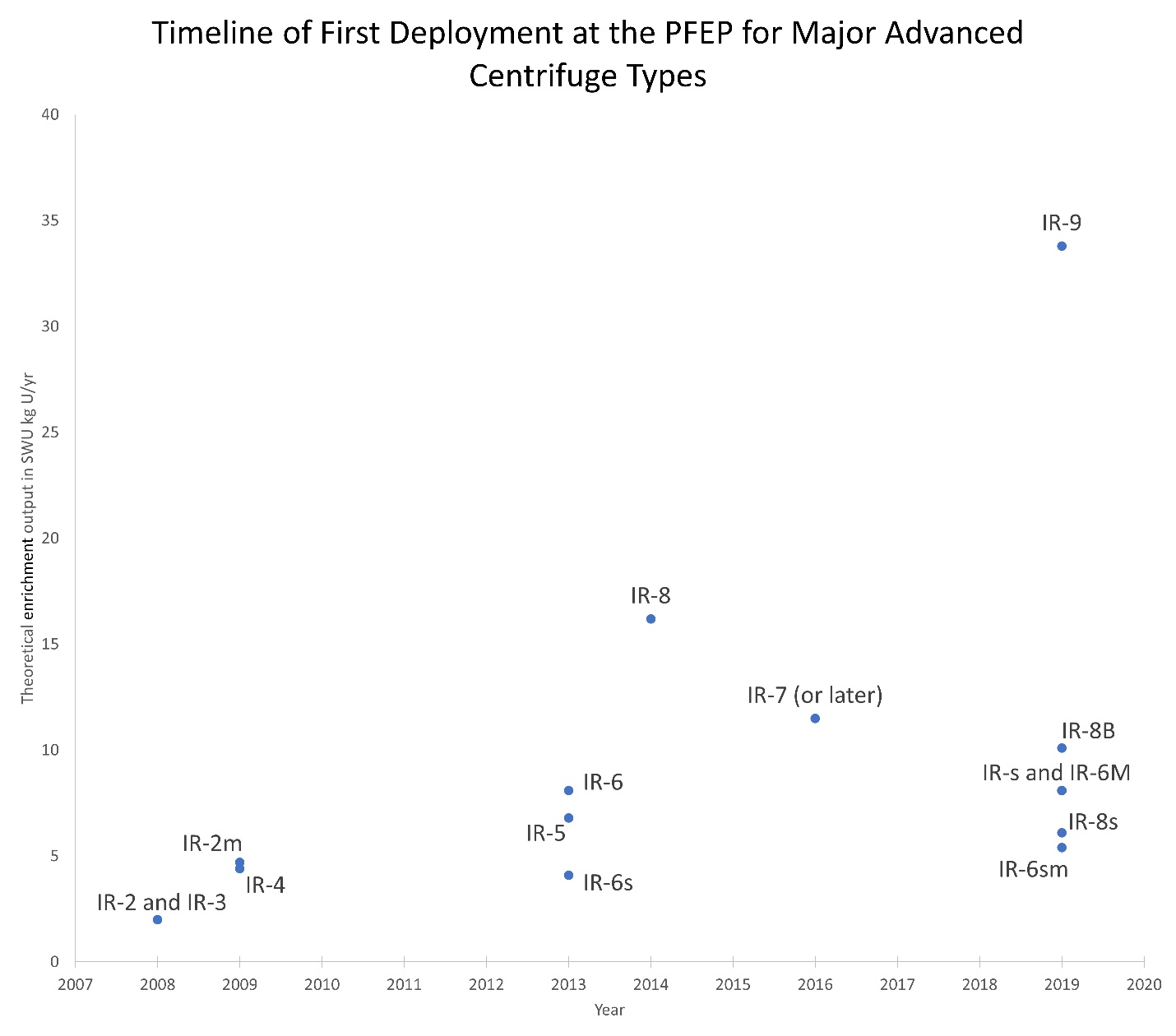
Figure H.2. Timeline of Iran’s deployment of major advanced centrifuge types at the Natanz Pilot Fuel Enrichment Plant, in relation to their theoretical enrichment output, starting with the IR-2 and IR-3 in 2008. Where data exist, the theoretical output proved significantly greater than the practical values Iran achieved when the centrifuges enriched uranium either alone or in cascades.
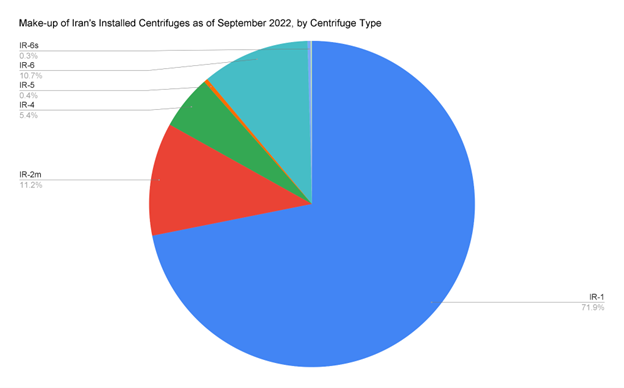
Figure H.3. The fraction by type and number of Iran’s installed centrifuges at all facilities as of September 2022. The IR-7 (1 installed), IR-8 (1 installed), IR-8B (1 installed), IR-9 (1 installed), and IR-s (10 installed) centrifuge types are represented on this graph, however, the respective counts are too few to be seen.
The JCPOA reduced the number of installed IR-2m and IR-4 centrifuges temporarily, but despite limitations, it only reduced the number of IR-6 centrifuges for a relatively short period of time, and it did not slow Iran’s ability to produce and deploy advanced centrifuges once Iran decided to stop abiding by the JCPOA limits (see Annex for their historical deployments). Iran has demonstrated its ability not only for a nuclear snapback but also for a snap nuclear buildup.
In reviewing Iran’s work on advanced centrifuges, the step from single machine tests to small cascade testing appears critical. However, under the JCPOA, this step was allowed from year one of the JCPOA’s implementation for the IR-6 and IR-8 centrifuges, and not enforced sufficiently for the IR-6 centrifuge.
Iran has gained valuable technical knowhow, experience, and advancements in the designing and building of its advanced centrifuges, further enabling a rapid build-back or buildup of centrifuge capabilities. Those gains cannot be reversed or erased, presenting further challenges to reestablishing JCPOA limits and raising serious questions about the value of reviving the JCPOA.
Figure H.4 provides Iran’s total historical theoretical enrichment capacity at Natanz and Fordow, where the IR-1 capacity is in blue and advanced centrifuge capacity is in red. So far, Iran’s current enrichment capacity has not exceeded its total capacity prior to the JCPOA’s implementation, but the nature of that capacity is shifting predominately to advanced centrifuges.
Nominal Enrichment Output of Advanced Centrifuges
Because of their far greater enrichment outputs, the installed advanced centrifuges, although many fewer in number, began in May 2021 to exceed the enrichment capacity of the several thousands of installed IR-1 centrifuges. As of September 2022, the advanced centrifuges numbered about 2782, or about 39 percent of the number of deployed IR-1 centrifuges at Natanz and Fordow, and they out-produced the 7110 deployed IR-1 centrifuges in nominal enrichment output by up to 85 percent (see Figure H.5 for a breakdown of the total installed enrichment capacity by centrifuge type). 11
If Iran reaches the projected number of about 4440 advanced centrifuges, they will contain about threefold the enrichment capacity of the currently deployed IR-1 centrifuges. This advanced centrifuge capacity will also exceed all of Iran’s estimated 16000 IR-1 centrifuges—deployed and stored—with only 28 percent of the number of centrifuges. This comparison ignores any stored advanced centrifuges.
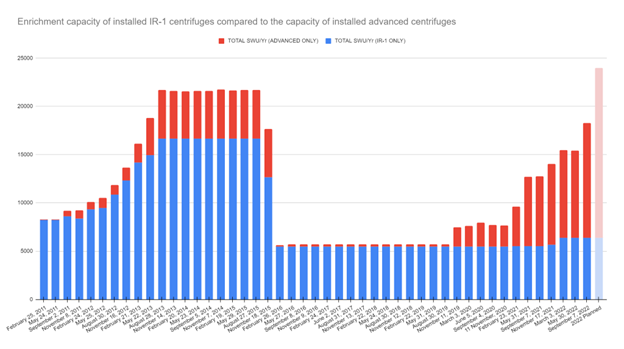
Figure H.4. Total enrichment capacity, by quarter, of the installed IR-1 and advanced centrifuges, with a projection on the far right of the graph.
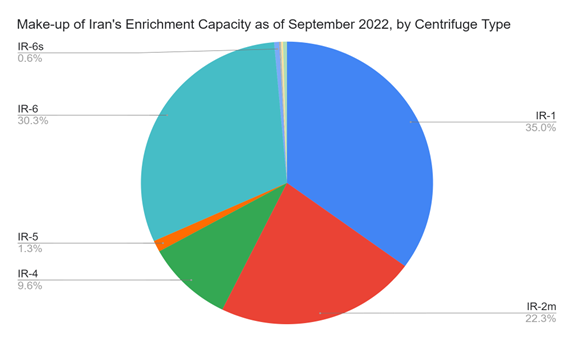
Figure H.5. The make-up of Iran’s total installed enrichment capacity organized by centrifuge type. Despite the IR-1 accounting for 72 percent of the total installed centrifuges in terms of number (see Figure H.3), it only accounts for about 35 percent in terms of the installed enrichment capacity. The IR-2m, IR-4, and IR-6 make up about 62 percent, and the IR-5 and IR-6s about 2 percent of the installed capacity. The other installed advanced centrifuge types contribute only slightly to the total capacity and are not annotated in the pie chart.
Increasing Advanced Centrifuges’ Enrichment Output
In its development of advanced centrifuges, Iran has lengthened their centrifuge rotor assemblies, boosted their wall speed marginally by increasing the diameter, and changed the rotor tube material to carbon fiber. Carbon fiber allows for higher rotor speeds than the high strength aluminum used in Iran’s IR-1 centrifuge. Iran could have also achieved higher speeds by opting for high strength maraging steel rotor assemblies, as Pakistan did, but Iran appears to have encountered difficulties procuring this material. However, excluding the IR-1 centrifuge, Iran’s enrichment output appears to have increased mostly with length, indicating Iran has had difficulties operating its centrifuges at the higher speeds offered by carbon fiber rotors.
Difficulties with high strength maraging steel appear to have also motivated Iran to develop the bellows, an important component of Iran’s longer centrifuges, from carbon fiber, although carbon fiber bellows are much more difficult to make than ones made from maraging steel. Not unexpectedly, Iran appears to have ongoing difficulties making carbon fiber bellows, continuing to deploy shorter centrifuge models that do not need a bellows in parallel to developing the longer centrifuges. It is also concentrating on deploying advanced centrifuges with only one bellows, a centrifuge design easier to develop than one with two or more bellows. In addition, as mentioned above, Iran may be substituting maraging steel bellows for carbon fiber ones.
The IR-s centrifuge bears watching. It is an outlier among the shorter centrifuges, with a relatively high theoretical enrichment output, implying a wall speed more consistent with the potential of carbon fiber rotors. Typically, Iran’s advanced centrifuges have achieved speeds less than optimal for carbon fiber rotors. However, the IR-s may be testing at these higher speeds, say of the order of 700 meters per second. Achieving these higher speeds is difficult but would allow significant increases in enrichment output.
In general, the AEOI has tried to develop many types of centrifuges, far too many for a commercial or economic program. Some of the developments, such as the proudly proclaimed very long centrifuges, appear aimed at impressing a domestic audience and not at large-scale deployments in a reasonable time frame. Nonetheless, the strategic nature of Iran’s centrifuge program cannot be ignored.
Uncertainties about Advanced Centrifuge Manufacturing and Outputs Growing
As discussed above, attacks on the Natanz Iran Centrifuge Assembly Center in July 2020 and the centrifuge manufacturing plant at Karaj in June 2021 have likely limited or slowed Iran’s ability to install advanced centrifuges. The September 2022 report indicates that Iran may have overcome some of those manufacturing and assembly setbacks. Iran has now reached the advanced centrifuge deployment levels outlined in its December 2020 law, almost two years after its passage.
Nonetheless, advanced centrifuge production rates continue to be hard to predict, because of unclear Iranian policies on the number produced versus deployed, and less Iranian transparency at its centrifuge manufacturing sites since February 2021. In addition, the sabotage events at Natanz and Karaj have limited the production of centrifuges to an unknown extent. The Wall Street Journal reported that the Karaj site resumed centrifuge production on a limited scale in August 2021 and accelerated production subsequently, producing “at least 170 advanced centrifuges” by mid-November. 12 The November 2021 IAEA report, however, contained no information on the operational status of the Karaj site. Shortly after Iran allowed the IAEA to re-install cameras at Karaj in December 2021, Iran announced it was moving the centrifuge rotor and bellows production workshop to a new site at Esfahan, subsequently changed to the FEP at Natanz. 13 Based on IAEA reporting, centrifuge part manufacturing has commenced at Natanz; Iran informed the IAEA that production of centrifuge rotor tubes and bellows would begin on April 13, 2022. 14 A year prior, Iran inaugurated a small, temporary workshop that serves as a centrifuge assembly facility at Natanz.
Construction of a replacement for the ICAC in a new tunnel complex is progressing visibly. 15 The new tunnel complex will harbor halls more deeply buried than the Fordow uranium enrichment site, itself deeply buried, and features tunnel entrances that appear better protected as well. This site is expected to be large enough to produce centrifuges on the same scale as planned for the ICAC, namely several thousand advanced centrifuges per year. In fact, the estimated available floor space underneath the mountain ridge and between the visible tunnel entrances appears to significantly exceed that of the ICAC, leading to concerns that the site may have additional purposes, including housing a small enrichment facility containing advanced centrifuges.
Sneak-Out in a Clandestine Plant
More powerful advanced centrifuges make it easier for Iran to set up a secret enrichment plant, which would be smaller and host only a fraction of the centrifuges Iran would have needed in 2009, when it was trying to finish and install IR-1 centrifuges at its secret enrichment plant near Qom (now known as Fordow FEP), designed to produce weapon-grade uranium. 16
Since only a relatively small number of advanced centrifuges would be needed to set up a secret and relatively powerful enrichment plant, concern increases about unaccounted production of major parts for advanced centrifuges or whole rotor assemblies.
The concern about Iran building another secret enrichment plant will undoubtedly grow with time, absent negotiated limits and far more robust IAEA inspections than have functioned in Iran with or without the JCPOA. After all, the Natanz enrichment plant and the Fordow enrichment plant were built in secret until exposed, the latter as part of a covert military program to produce weapon-grade uranium, a facility that went undiscovered for upwards of six or seven years. 17 With advanced centrifuges, a secret plant could be smaller, more capable, and harder to discover, and this possibility should not be discounted.
Annex. Numbers of IR-2m, 4, and 6 centrifuges, historical deployments, by quarter
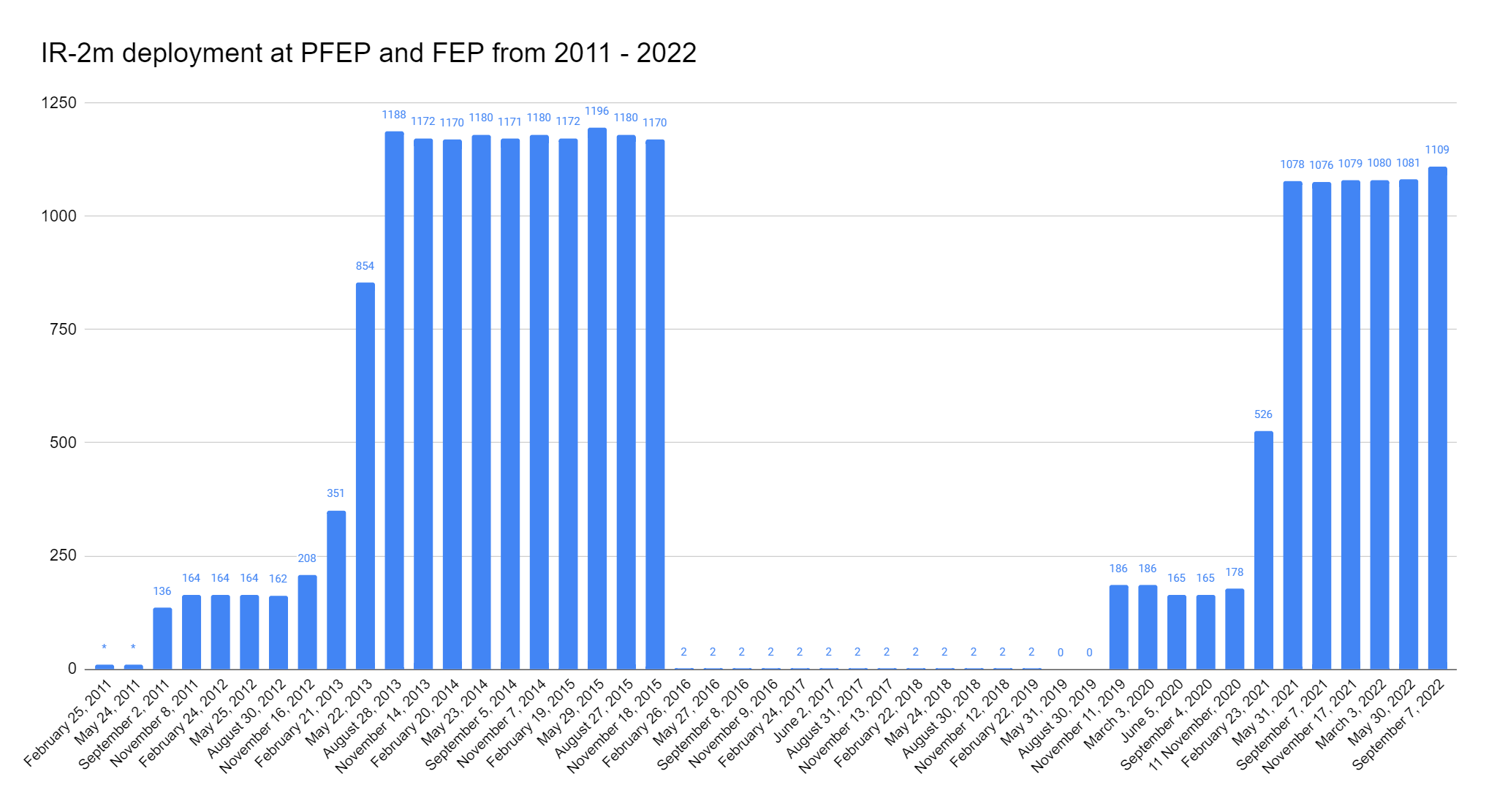
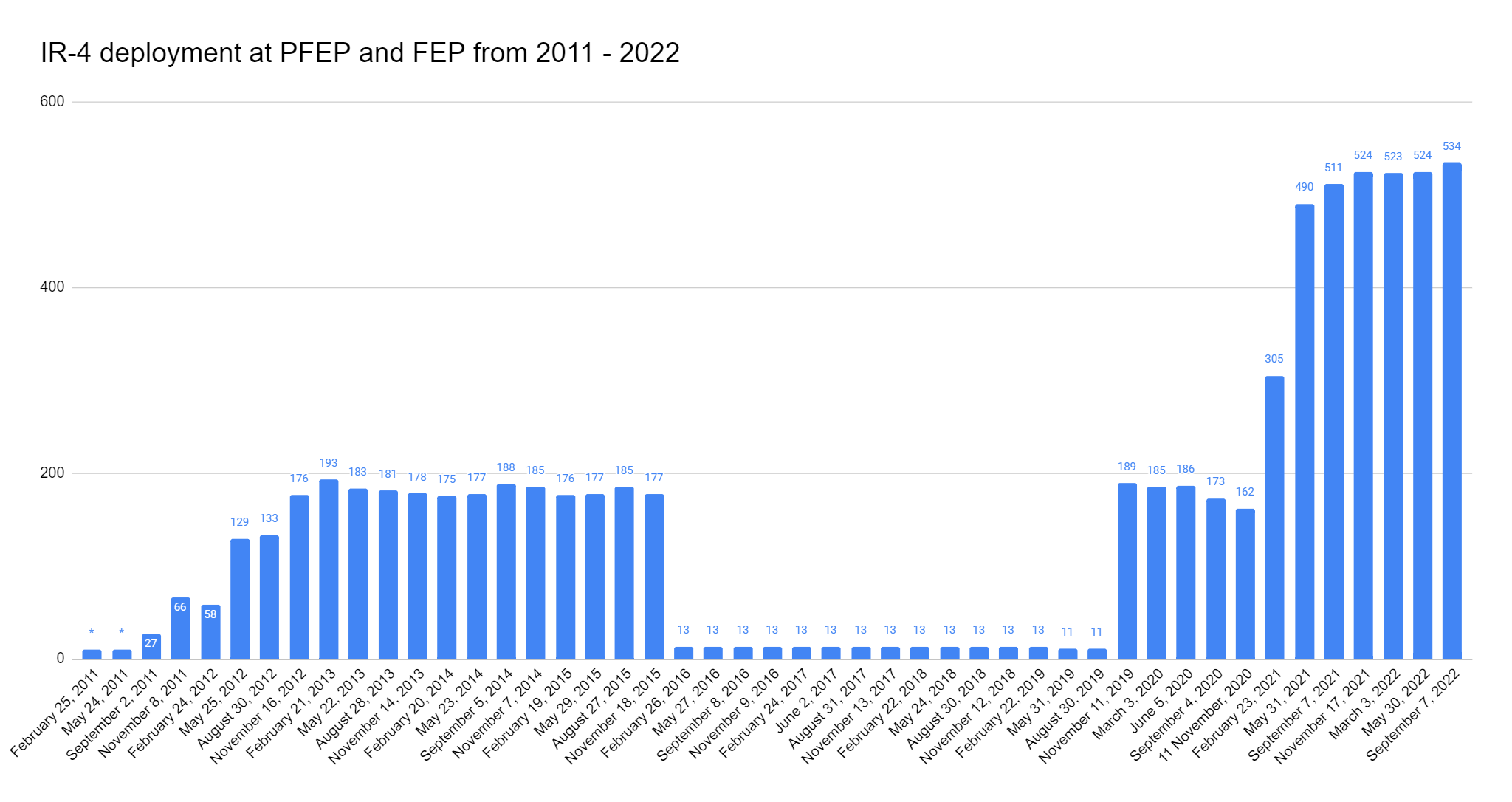
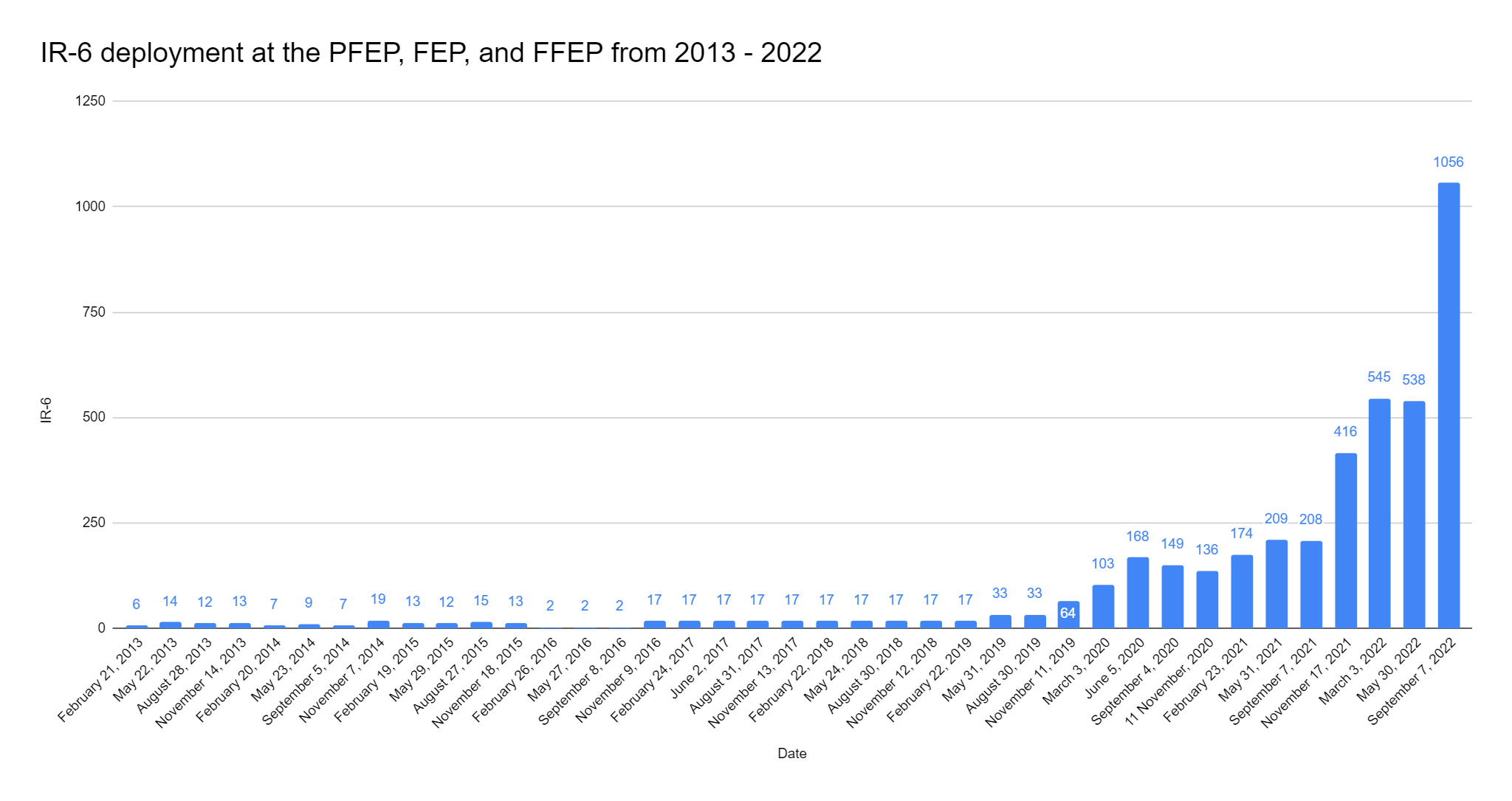
1. David Albright, Sarah Burkhard, and Spencer Faragasso, “A Comprehensive Survey of Iran’s Advanced Centrifuges,” Institute for Science and International Security, December 2, 2021, https://isis-online.org/isis-reports/detail/a-comprehensive-survey-of-irans-advanced-centrifuges/8. ↩
2. Nominal enrichment output assumes the centrifuge outputs in Table H.1; actual values could be less. Similarly, for the IR-1 centrifuges. ↩
3. David Albright, Sarah Burkhard, and Andrea Stricker, “Analysis of IAEA Iran Verification and Monitoring Report - September 2022,” Institute for Science and International Security, September 9, 2022, https://isis-online.org/isis-reports/detail/analysis-of-iaea-iran-verification-and-monitoring-report-september-2022/ ; IAEA Director General, Verification and monitoring in the Islamic Republic of Iran in light of United Nations Security Council resolution 2231 (2015), GOV/2022/39, September 7, 2022, https://www.iaea.org/sites/default/files/22/09/gov2022-39.pdf.↩
4. David Albright, Sarah Burkhard, and Spencer Faragasso, “Iran’s Latest Advanced Centrifuge Deployment,” Institute for Science and International Security, August 4, 2022, https://isis-online.org/isis-reports/detail/irans-latest-advanced-centrifuge-deployment.↩
5. Verification and monitoring in the Islamic Republic of Iran in light of United Nations Security Council resolution 2231 (2015), GOV/2022/39, September 7, 2022. ↩
6. David Albright and Sarah Burkhard, “Video Walk-Through of Iran’s New Interim Centrifuge Assembly Center,” Institute for Science and International Security, June 29, 2022, https://isis-online.org/isis-reports/detail/video-walk-through-of-irans-new-interim-centrifuge-assembly-center/8. ↩
7. David Albright and Sarah Burkhard, “The IR-6 Centrifuge Needs Further Development,” Institute for Science and International Security, July 14, 2022, https://isis-online.org/isis-reports/detail/the-ir-6-centrifuge-needs-further-development/8. ↩
8. As discussed in the main report, the associated single machine theoretical values for the IR-2m, IR-4, and IR-6 centrifuges are 4.4, 4.7, and 6.7 SWU/year/centrifuge, respectively. For comparison the single machine theoretical value for the IR-1 centrifuge is 1.4 SWU/year/centrifuge. ↩
9. “Iran’s Long-Term Centrifuge Enrichment Plan: Providing Needed Transparency,” Institute for Science and International Security, Re-released April 25, 2019; Originally issued August 2, 2016, https://isis-online.org/isis-reports/detail/irans-long-term-centrifuge-enrichment-plan-providing-needed-transparency/8. ↩
10. David Albright, Sarah Burkhard, and Andrea Stricker, “Analysis of IAEA Iran Verification and Monitoring Report - February 2021,” Institute for Science and International Security, February 25, 2021, https://isis-online.org/isis-reports/detail/analysis-of-iaea-iran-verification-and-monitoring-report-February-2021/8. ↩
11. Nominal enrichment output assumes the centrifuge outputs in Table H.1; actual values could be less. Similarly, for the IR-1 centrifuges. ↩
12. Laurence Norman, “Iran Resumes Production of Advanced Nuclear-Program Parts, Diplomats Say,” The Wall Street Journal, November 16, 2021, https://www.wsj.com/articles/iran-resumes-production-of-advanced-nuclear-program-parts-diplomats-say-11637079334. ↩
13. David Albright, Sarah Burkhard, and Andrea Stricker, “Analysis of IAEA Iran Verification and Monitoring Report - March 2022,” Institute for Science and International Security, March 4, 2022, https://isis-online.org/isis-reports/detail/analysis-of-iaea-iran-verification-and-monitoring-report-march-2022; Francois Murphy, “Iran moves centrifuge-parts workshop underground at Natanz, IAEA says,” Reuters, April 28, 2022, https://www.reuters.com/world/middle-east/iran-set-up-centrifuge-parts-workshop-underground-natanz-iaea-says-2022-04-28/ ; and IAEA Director General, Verification and Monitoring in the Islamic Republic of Iran in light of United Nations Security Council Resolution 2231 (2015), GOV/INF/2022/11, April 14, 2022. ↩
14. David Albright, Sarah Burkhard, and Andrea Stricker, “Analysis of IAEA Iran Verification and Monitoring Report - May 2022,” Institute for Science and International Security, June 6, 2022, https://isis-online.org/uploads/isis-reports/documents/Analysis_of_May_2022_IAEA_Iran_Verification_Report_June_6_2022_Final.pdf. ↩
15. David Albright, Sarah Burkhard, and John Hannah, “Iran’s Natanz Tunnel Complex: Deeper, Larger than Expected,” Institute for Science and International Security, January 13, 2022, https://isis-online.org/isis-reports/detail/irans-natanz-tunnel-complex-deeper-larger-than-expected. ; and David Albright and Sarah Burkhard, “Imagery Update: Iran Continues to Harden its New Natanz Tunnel Complex,” Institute for Science and International Security, May 5, 2022, https://isis-online.org/isis-reports/detail/imagery-update-iran-continues-to-harden-its-new-natanz-tunnel-complex-2022/8. ↩
16. David Albright with Sarah Burkhard and the Good ISIS Team, Iran’s Perilous Pursuit of Nuclear Weapons, (Washington, DC: Institute for Science and International Security, 2021). ↩
17. Iran’s Perilous Pursuit of Nuclear Weapons. ↩


 twitter
twitter